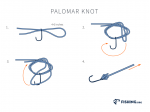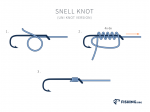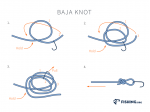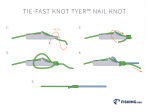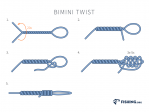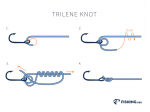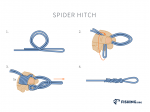Blood Knot

Blood Knot
In order to make a Blood Knot you need at least two lines to join together. This type of knot has become known as a tried and true fishing knot. This knot also works best when the two lines are pretty much equal in diameter.
Step 2:
Step 3:
Another way to make this knot is to simply overlap the two ends and twist them together for ten to fourteen turns before going to the center and creating a hole. Next, you want to pass the two ends in the opposite direction through the hole.
A favorite fishing knot, the Blood Knot, is also called the “Barrel Knot.” Whichever name you use does not matter as its purpose remains the same.
This is a "bend knot" for anglers to join sections of monofilament nylon line or fluorocarbon line of similar diameters, such as when adding a new line onto a half-filled reel spool.
Its primary purpose is to join the lines while maintaining most of the line’s strength.
There are other fishing knots that fishermen and women can use for this same purpose, but they often cause a substantial loss of strength to the line, making it weak and easy to break.
The Blood Knot has several uses and has become a tried and true fishing knot.
When to Use a Blood Knot?
Since the Blood Knot is the tying of two lines of similar size or diameter together, many believe it to be one of the more ideal knots to join sections of the tippet or leader.
It is a perfect tie for fly fishermen and women to use while fly-fishing. It is relatively simple and quickly learned. This angling knot serves to build a leader of gradually decreasing diameter with the castable fly line. Attach it at the large diameter end with the fly or at the small diameter end with the hook.
The strength of the knot depends on the number of turns. You need to make at least five to seven turns on each side of the center.
Blood Knot Uses:
- In fly-fishing.
- To construct fishing leaders.
- Like a decorative stopper knot in sailing
- For the leader to tippet and fishing line to leader connections.
The Principal Drawback to the Blood Knot
Although the Blood Knot’s level of tying difficulty is not extreme, some will not use it because of its need for dexterity to tie the knot.
The Blood knot is "a double overhand knot tied in a cat-o'-nine-tails" and is a favorite knot to tie.
How to Tie a Blood or Barrel Knot
To make a Blood Knot, you need to join two lines together. You can use either mono or fluoro lines, but the two lines must equal in diameter.
Here is a step-by-step guide on how to tie a Blood Knot:
- Cross about ten inches of the tag end of each line, so they form an X. If you want to join the ends of the lines, they need to overlap in the very first step.
- Then pinch the two lines with the right hand and use the left hand to make five turns around the line on the left. Basically, you need to twist one wire around the other to make the turns.
- Next, you need to pass the left tag end behind the line on the right at the X.
- Now, pinch the left-side tag end and wrap it with the left hand. At the same time, make five wraps of the line on the right.
- Pass the right-hand tag end through the small opening formed at the X. The goal is so the two tag ends point in opposite directions.
- Remember to lubricate the knot and to pull it tight with steady pressure. By drawing on each line, you will force the wrapped turns to move the twists, so the inner strand becomes an outer wrap. The knot changes in structure.
- Clip the tag ends to close the barrel wraps.
Conclusion
Once you tie a Blood Knot, it should end up reasonably symmetrical around the middle. It is one of the best knots to use, especially for the times you use a small, stiff, or slippery line. Thus, the perfect fly-fishing knot.
 Carla Arbuckle
Carla Arbuckle 
